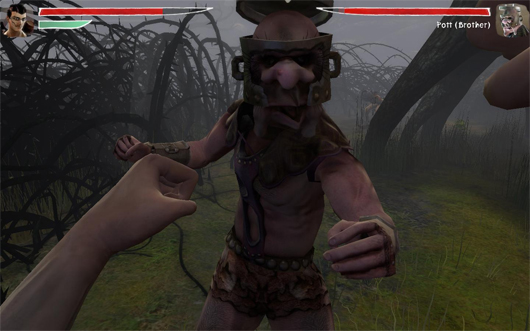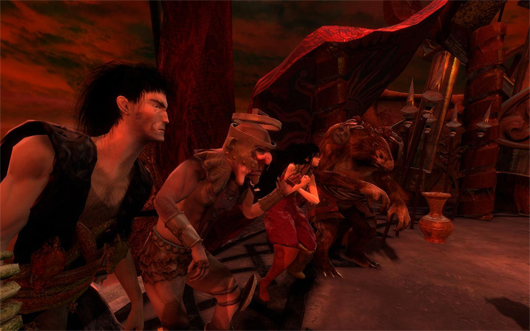Zeno Clash is an independent, PC-only first-person beat ’em up, released for digital download on Steam and Direct2Drive. It was created by Chilean studio Ace Team, and has turned many heads even prior to its release, its hype (for lack of a better word) driven by its completely original world design and aesthetic appeal, and only secondarily by the fairly innovative gameplay idea of a first-person beat ’em up.
It can be hard to explain how the game plays out because there’s not a lot to directly compare it to. It has been termed a fighting game in sub-genre, but it only fits that genre in the sense that each instance of combat feels like an instanced fight, as the game starts the combat with a slide-in versus screen, and you can only continue further into the world once the fight is closed.
But what else to compare it to? Riddick and Fallout 3/Oblivion jump to mind, but the fighting in those games does not feel half as direct as that in Zeno Clash. I personally feel that despite the first-person camera, the combat best suffers comparison to the beat ’em ups of the 80s/90s, such as Double Dragon and Streets of Rage. Like these games, the basic control set-up is simple, and unlike the fighting game genre the combinations you can make tend to be short, one-two-three-throw moves rather than expanded key combinations to do a variety of super moves.

Like beat ’em ups, the portfolio of moves consists of punches, kicks and throws. Like beat ’em ups, it has a linear story, heavily reuses characters, meaning you can fight the same enemies over and over, and heals the player with fruit lying on the floor, as well as auto-healing between fights (perhaps more like fighting games in that instance). And, like beat ’em ups and unlike fighting games, pure skill at combinations is less important than a good intuitive feel for the way fights work. Singling out opponents and moving around a lot when fighting a group is more important than blocking. The blocking and dodging moves the game offered are just as easily replaced by quickly moving back and forth. The system is not simple enough for many players to master all combinations, but a bit of common sense can get you through fights just as easily.
One thing that does set it apart quite a bit is the usage of weapons, including guns (though I suppose Streets of Rage 3 had this as well). Perhaps unsurprisingly, the shooting action feels a lot more contrived. The guns are beautifully designed parts of the world, an do not feel like conventional FPS weaponry even though a few of them are (double pistols, rifle). But I would think most people prefer to keep their weapons holstered and go for the more direct approach whenever they can. The game does not force you into using weapons often, and in the Hunter boss sequence it pulls the need for a gun off really well, but Zeno Clash does occasionally stack the odds against you in a way that makes having a gun handy.
The other type of weapon is the traditional beat ’em up club, though baseball bats and iron pipes are replaced by weird-looking hammers and bone swords. Of all the action sequences, the ones featuring clubs are my least favorite. In particular fights with heavies feel unnecessary and cumbersome, lacking both the immediacy and intuitiveness of other fights.
In general, fights are interesting and Zeno Clash offers plenty of novel new situations to keep you interested, but at the end of 4-hour ride it’s already getting a bit repetitive, and it’s a good thing it doesn’t last much longer. If you are hungry for additional fights, the game offers a 5-tier challenge mode with interesting combat situations. Still, first-person beat ’em up gameplay hasn’t been done often, and it very rarely has been done well. Zeno Clash lacks the quality of close combat on the level of Mount & Blade, but it is superior to that of Oblivion. It’s good, but it’s not good enough to carry the game by itself.
What really carries the experience is the world design. It’s like stepping into a nightmare sequence from a Cronenberg film, or right into a Dali painting. Angular architecture defying you to look at it, weird yet disturbingly familiar characters and animals, strange plants with claw-like branches and almost animal-like properties, it all combines for a world that follows no logic other than its own, breath-taking in beauty and consistent enough to remain believable as a whole.
While the game may lack the graphics of a current-gen AAA, it more than makes up for it in pure strength of design, and puts many if not all of the recent top-level games to shame in its originality and quality. Heck, it bares comparison only to the likes of Planescape: Torment and Sanitarium in how well it pulls off a beautiful, weird world. The game is worth playing purely for the experience of its weird world, and it’s not until the last quarter or so when you backtrack through the same old locations and enemies that the roller coaster ride lets up.

You explore the world in a linear romp of a story, tracking through set fights and non-branching corridors, though the game does a good job of making you forget about how linear it is and making the world feel more open than it really is. There’s two storylines you play through, one being memories of the events leading up to the game’s start, and the other being the story of the main character, Ghat, and his companion, Deadra, fleeing the scene of Ghat’s crime. The story revolves around Father-Mother, the androgynous progenitor of an entire clan of brothers and sisters. As the story progresses, you are introduced to a picking of elements of the world, Zenozoik, from the Corwids of the Free who roam the forest near the city, to the rarely traversed desert and the darkness beyond it.
It’s a fascinating string of ideas, and the main plotline itself is good enough even if it does leave a few too many things unexplained. But where it sadly falls apart is presentation, which ranges from ok to the painfully amateurish. It’s not just that the voice acting never goes above passable (and often falls below the acceptable), a consequence of it being done by the team itself, but the writing just isn’t very good. It feels like you’re reading the cliff notes of a mediocre translation of Master and Margarita – the ideas are there, the layers of meaning and the possibility of philosophical and political depth exist, but they’re just not there in the game itself. The English isn’t broken, but it doesn’t flow naturally in a way that pleases the ear. The voice-overs don’t grate (much), but nor do they really entice.
The Corwids of the Free are a sad example of this. This clan (if they can be called that) are an expression of Aristotelean/Ramana Maharshi self-realization an extreme of the idea that happiness and fulfillment comes from realizing your potential, pushing it far enough to disregard society’s standards and morals. For the Corwids this potential often takes the form of a single action, whether it be walking in a straight line or believing you need to be invisible and – for that reason – removing the eyes of everyone who sees you. Fascinating stuff potentially, and the character design is there both in ideas and in visuals, but when you reach this point in the plot and Ghat drones his mediocre lines in a boring, non-committal voice, it takes an effort to see the potential, the game itself certainly not helping you along.
It’s a slight down note on a great accomplishment. It pulls off an original combat system well, and created an incredible, novel game world. Through heavily reusing character models and other art assets in well-paced levels, Ace Team shows a finesse in design that overcomes many budgetary shortcomings, it is only the story presentation where it catches up with them.

















